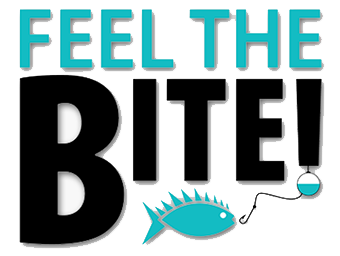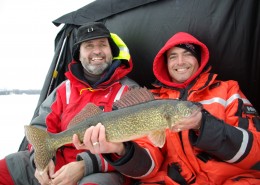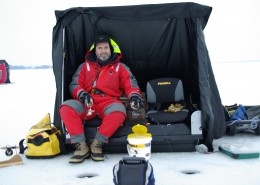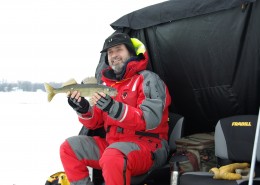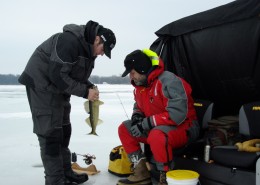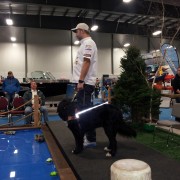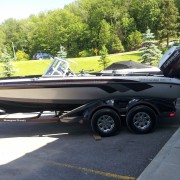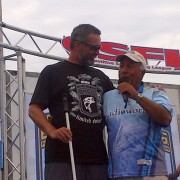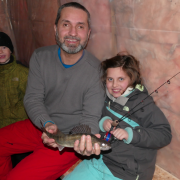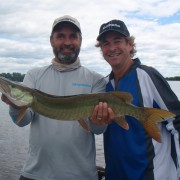Feeling Around for Some Bay of Quinte Beauties
With Scott Campbell doing the driving and taking the photos, the two of us set off for the Bay of Quinte to meet up with the Quinte Ice Fishing Team. I wanted to feel for myself the magnificent Walleyes that fishers routinely pluck out from under the ice. We met up with Jeff Chisholm and his partner Paul McTaggart at 5:30 on a Saturday morning at a Tim Horton’s in Bellville on December 28, 2013, along with several other of the Team’s guests for the day.
While waiting for my turn to be transported on to the ice at the launch sight, I spoke with a local who showed up that morning specifically to observe where the Quinte Ice Fishing Team planned to fish that day. Even though both Jeff and Paul deliberately set off from the launch in false directions prior to extinguishing their tail lights and changing courses for the intended destination, by no means did we end up with a chunk of Bay ice to ourselves. They had us positioned over 12-inches of ice and 19-feet of water with all holes drilled by 6:30.
Jeff and Paul tested baits constantly and circulated among the four of us guests to pass on information about which baits and techniques were icing fish. From 6:30 to 9:30, the bite can be quite hot, and in spite of the four of us losing five Walleye sub-surface, we managed to successfully ice ten or so decent Walleye measuring between 16 and 25 inches.
An extreme low pressure system had moved in the day before bringing temperatures up to just above zero. Sudden barometric shifts such as this always result in neutral fish, but given that we were on the ice within three weeks of its forming, there was still plenty of action to be had. Strikes were most often sudden and aggressive, but the occasional Walleye had to be finessed into biting – the longest “cat-and-mouse” game lasted 12 minutes and lured the fish 4-feet off the bottom.
Throughout the 11 hours on the ice, Jeff or Paul would be firing up either a BBQ or deep fryer making sure we were well fed. If it wasn’t hot sausages, it was fresh buns stuffed with Walleye smothered in tartar sauce. The Team also made sure everyone had access to the hottest artificial baits and an ample supply of live minnows, and was quick to offer up fresh propane tanks and 12V batteries when the need arose. Between the food, drinks, supplies and tips, none of us had anyone to blame but ourselves if more than an hour past without a fish.
As big as the Bay of Quinte is, even 20 feet can make the difference between catching fish or not. However, with Paul and Jeff constantly scouting, it wasn’t long before anyone of us four guests found ourselves being shifted over to a more productive location. It’s this sort of constant attentiveness to the fishing needs of the guests that keep people coming back to the Prince Edward county area year-after-year even if it means driving from as far away as London, which was the case of the Ice Team’s other two guests.
Hot baits were flutter-type spoons with rattles in a chartreuse colour. Dead-sticking live bait is rarely a productive method on the Bay during the winter, for whatever reason, resulting in seasoned pros such as Jeff having developed a two-handed “double-barrelled” approach to jigging. One rod is rigged with a “call” type bait, such as lipless rattle baits, and the second has a vertical presentation tipped with a full minnow.
Cadence for the baits generally consists of a 6-inch snap up of the rod tip using the wrist, with as much as a 3-second pause between snaps during which the bait is pulsed. When a fish is marked on the sonar, the “teaser” style bait is reeled up, and if this doesn’t result in a strike, the Walleye is then left with a single target to focus on. The 2-handed method takes some coordinating, especially when reeling up, but will increase your odds significantly given the amount Walleye move around under the ice. It would seem that Quinte Walleye never cease patrolling the thousands of acres of the Bay’s nearly featureless bottom.
In spite of The Bay of Quinte being part of Lake Ontario, wind patterns pushing the open water on the lake either towards or away from the Bay result in currents being established under the ice. These currents and slack water areas influence exactly where the Walleye will or will not be at any specific time in the winter. These currents can also produce dangerous ice conditions as they ware ice away from underneath – a hazard that’s difficult to detect visually from above. Having guides who spend almost every winter day on the ice keeping you safe can make a lot of sense if you’re from away.
After several seasons of relatively pour ice conditions, all indicators would seem to suggest this year’s ice fishing on the Bay of Quinte will be excellent. What little snow there was on top had pretty much melted and soaked into the more porous ice below during the weekend we were there. With the return of the extreme cold that followed, solid ice should be around for some time to come.
At the end of the day, Scott and I left for Ottawa with five decent eater-sized fish. No truly large Walleyes were kept, but just knowing they are there will keep bringing us and others back year-after-year. A big thanks to Jeff and Paul for the great day on the ice, and to Scott for applying his driving and photographic talents, not to mention his “blow-by-blow” colour commentary as he verbalized the action being revealed on my Lowrance elite Five Ice Machine.
Not being able to see the display on the fish finder myself, I fish hard all day just like everyone else did prior to sounders coming on to the scene. I still manage to catch roughly the same numbers of fish as others. It would seem the primary benefit of using fish finders on the ice is keeping fishers focussed on their fishing. Having said that, these sounders really come into play later in February when the Walleye stop feeding and the only way to elicit a strike is to tease them as if you were using a ball of string to provoke a big-old lazy house cat to pounce.
